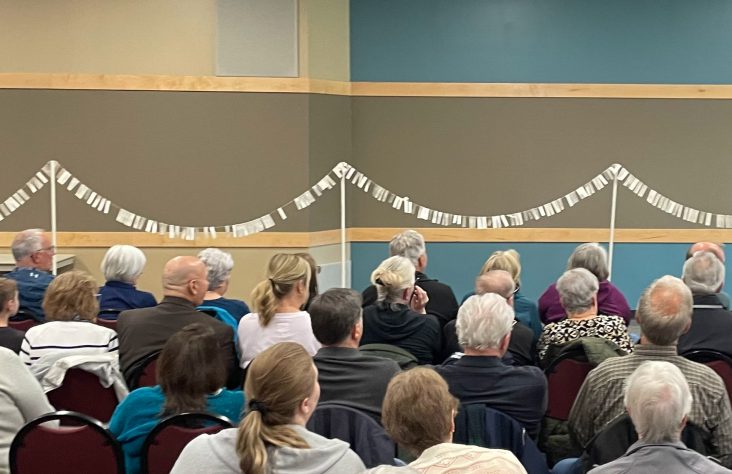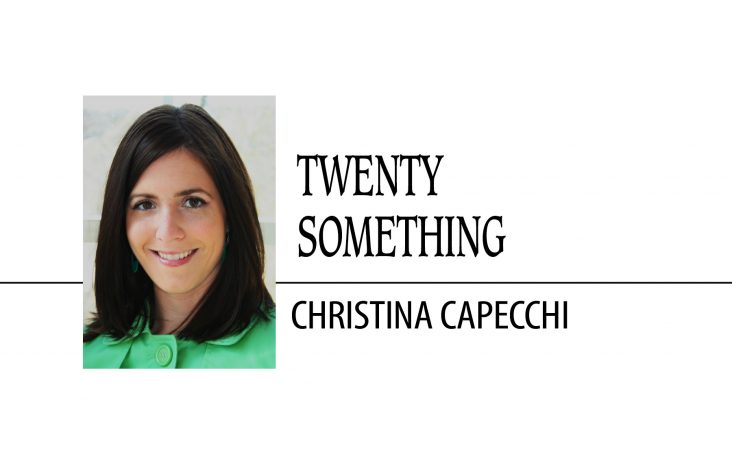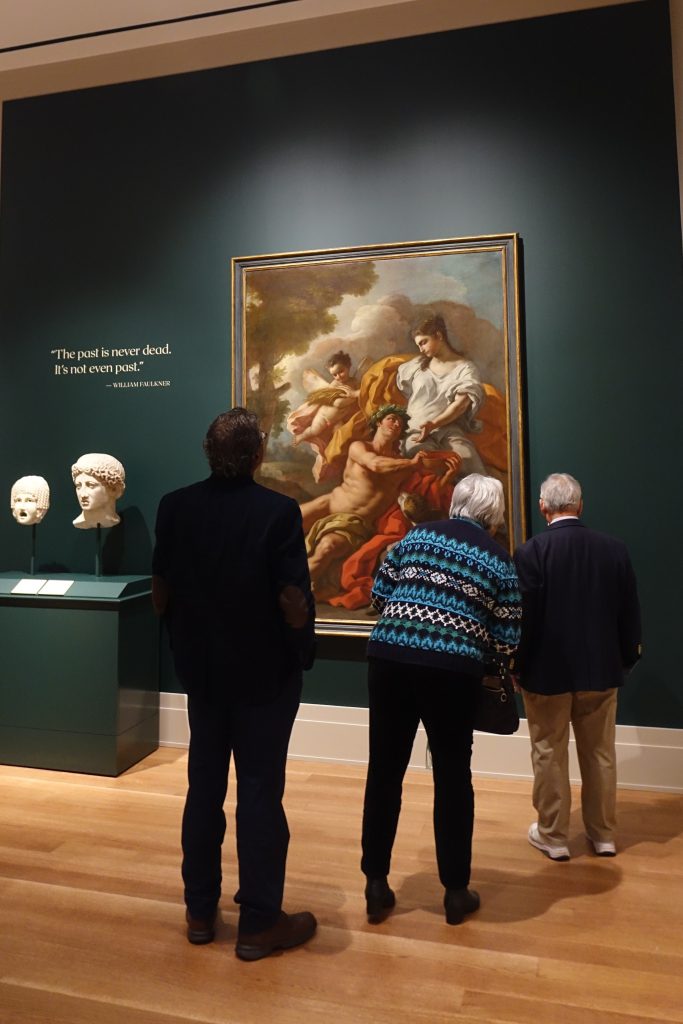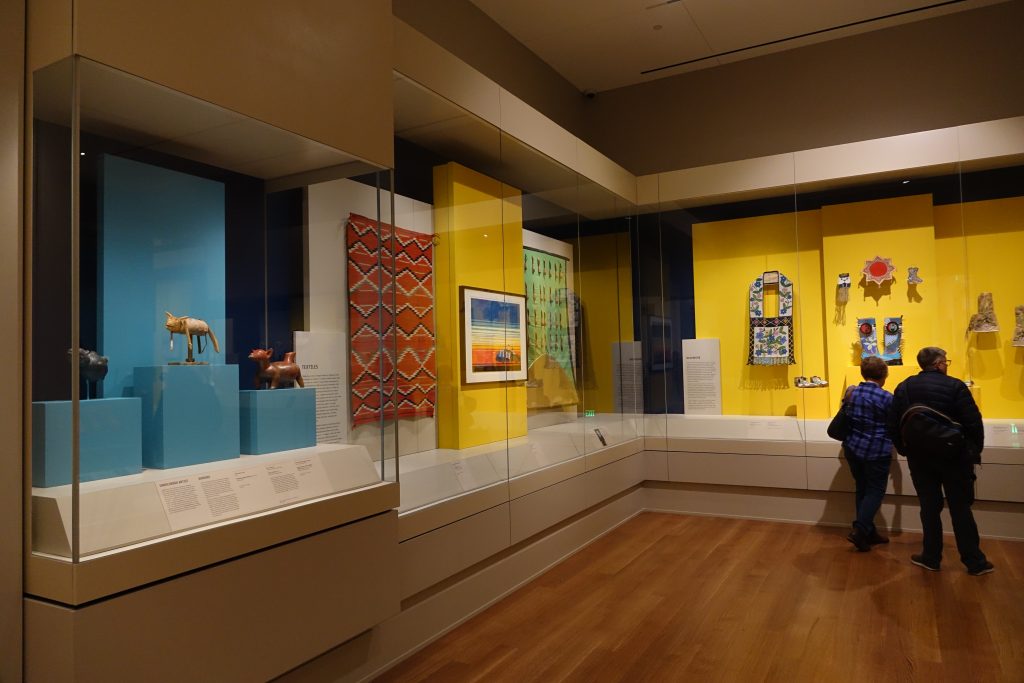December 12, 2023 // Diocese
Raclin Murphy Museum of Art Opens at Notre Dame
An installation on the facade of the Raclin Murphy Museum of Art reads, “We are in the midst of reality responding with joy.” The museum’s collection – and even the museum itself – is the result of artists doing just that.
The Raclin Murphy Museum of Art is the culmination of at least 20 years of discussions at the University of Notre Dame about finding a permanent home for its extensive art collection. During its grand opening on December 1-3, the museum saw more than 4,000 visitors pass through its doors. The museum is open to the public six days a week and is free to all visitors.
“We’re seeing a huge breadth of our community come in,” said Laurene Grunwald, Associate Director of the museum.
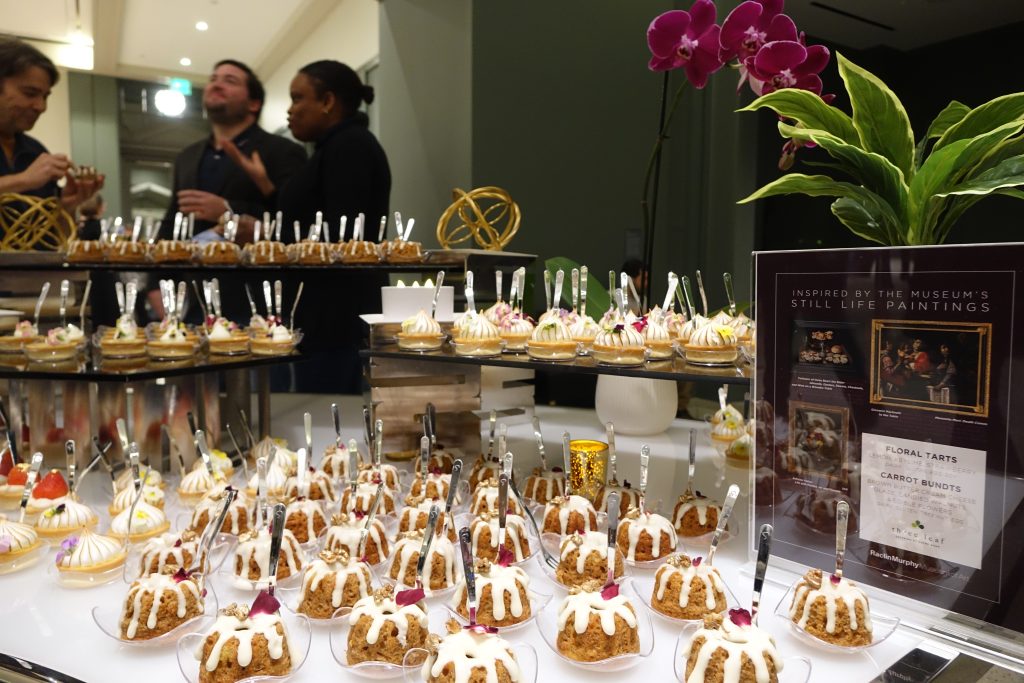
Visitors of all ages enjoy desserts prepared by Notre Dame pastry chefs and inspired by art on display in the Raclin Murphy Museum of Art.
Grunwald credited much of the success of opening week to the creativity of the events and special promotions, from pastries inspired by art in Raclin Murphy’s collection and a DJ on Friday night, to various dance and musical performances, Shakespearean monologues, and local artist demonstrations on Saturday and Sunday. The staff also provided ways to engage explicitly with the art, with sketchbooks and reflection prompts available throughout the weekend.
Notre Dame’s art collection is one of the largest academic collections in the United States, and it has a long history. As early as 1875, the main building of the college – which at that time held classrooms, dormitories, and more – housed an art museum on the top floor. More recently, the university’s collection was housed on campus at the Snite Museum of Art.
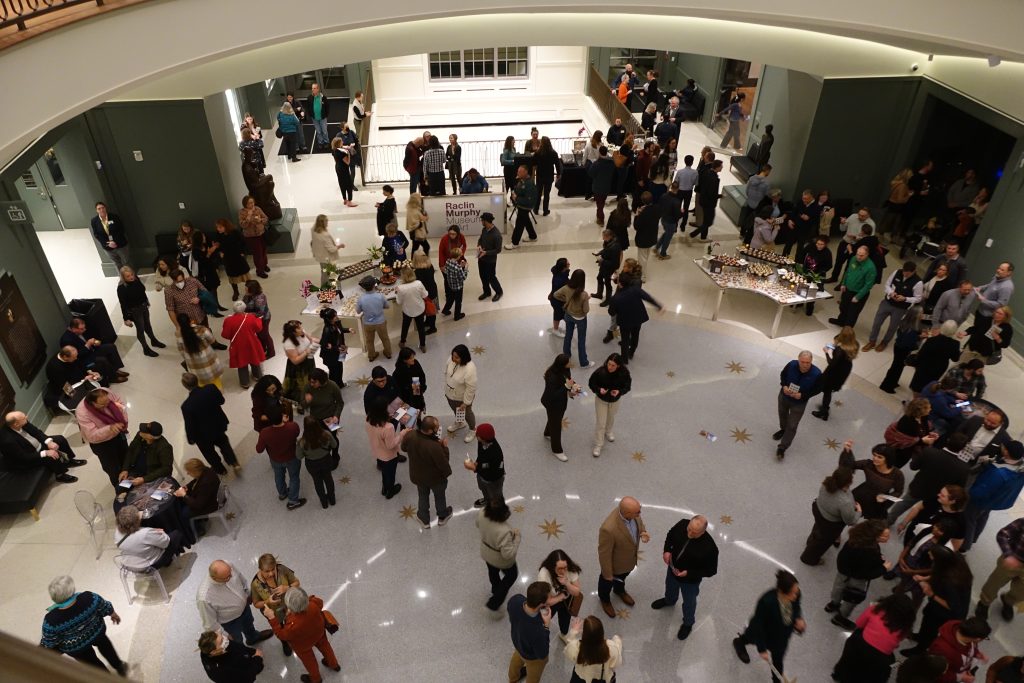
Visitors mingle in the lobby during the Raclin Murphy Museum of Art’s grand opening. Friday evening at the museum included hors d’oeuvres, a DJ, and guided prompts through the galleries.
Joseph Becherer, Curator of Sculpture and Director of the Raclin Murphy Museum of Art, said the Snite building became insufficient as both the collection and the university grew. Another issue was that the road and parking lot that led to the Snite were built over, making it much more difficult to visit. “There had been a longstanding desire, and then commitment, to basically pull the museum out and make it as accessible to the world as possible,” Becherer said.
After a donation from Ernestine Raclin and Chris and Carmen Murphy, for whom the museum was named, the project began in earnest in 2017. Work continued remotely throughout the COVID-19 pandemic to a delayed groundbreaking in April of 2021. Now the finished museum stands at the edge of campus at an extremely accessible intersection, with free parking readily available.
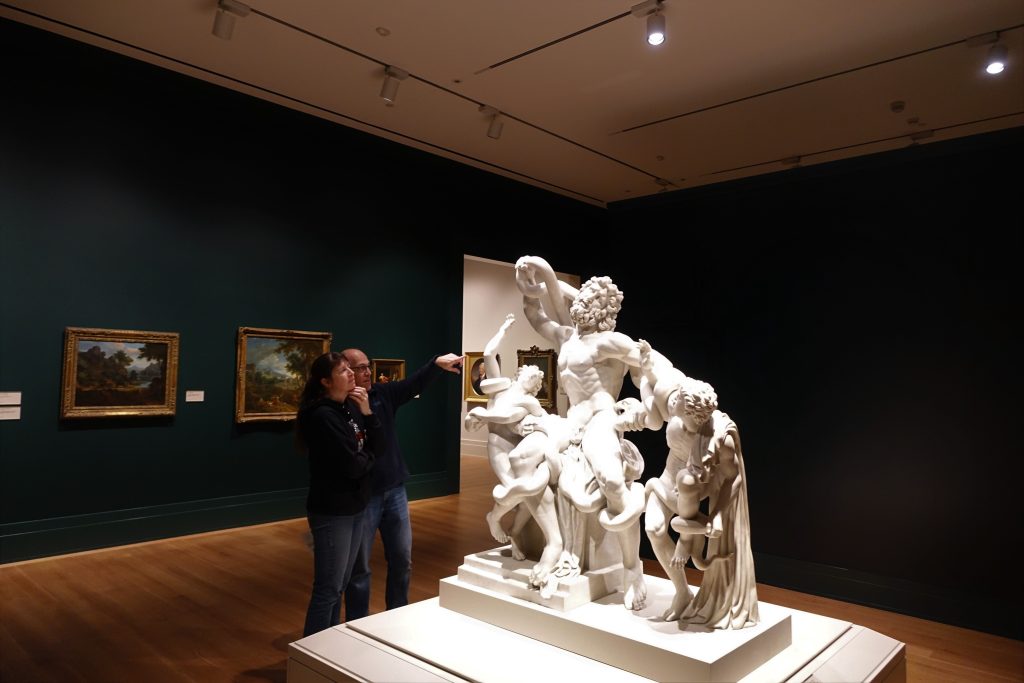
Visitors marvel at the Italian sculpture Laocoön and His Sons, a smaller version of a statue housed in the Vatican.
The Raclin Murphy Museum houses much of the collection kept formerly at the Snite building, which has now become the Snite Research Center in the Visual Arts. “Everything’s going to seem very fresh and very new because the context is so very different,” Becherer said. “We’ve never really had the luxury of 16-foot ceilings and huge, vast expanses of space.”
The building has four floors total – three stories and a lower level. The circular lobby forms the center around which the galleries gather. The lobby itself is a work of art, featuring hand-cast stars in its floor by artist Kiki Smith, who took inspiration from medieval, Renaissance, and Byzantine depictions of Stella Maris: Mary, Star of the Sea. The clean expanse of ceiling above the third story adds to the airy feeling of the museum, along with the blending of earth, sea, and sky in its interior architecture, which reflects the caption on the sculpture at the museum’s entrance: “Our search for knowledge is endless – it joins earth and sky.”
The museum’s collection extends across time and space, spanning continents and centuries. Some featured artists will be familiar to any student of art: Rembrandt, Dürer, Rodin. Some works will be familiar to those who visited the former Snite museum; some are brand new.
An example of a work newly on display is Vincenzo Spisanelli’s 17th-century altarpiece Noli Me Tangere, a depiction of Christ’s appearance to Mary Magdalene after His resurrection. The painting is Spisanelli’s only altarpiece displayed in a public collection in the United States. After spending decades in the vaults of the Snite, Noli Me Tangere spent months in conservation. As Becherer explained, conservation uncovered details that were hidden before, such as the garden in the background and even Christ’s original beard in the painting – a goatee, which had been painted over later with a full beard.

Visitors spend time in the Mary, Queen of Families Chapel on the second floor of the Raclin Murphy Museum of Art. The ceiling mosaic and stained glass are special commissions from Italian artist Mimmo Paladino.
In addition to the lobby, the museum comprises several commissions specific to the building and site, one of the most prominent being the Mary, Queen of Families Chapel on the second floor. Icons and vessels in the chapel are centuries old, yet the mosaic ceiling and backdrop are brand new. Museum officials commissioned Mimmo Paladino, a renowned Italian artist, yet these works include many symbols referencing the local St. Joseph River valley, the University of Notre Dame, and its founding Congregation of Holy Cross. Many of the symbols look primitive, as if drawn by children, yet much of the medieval art in the chapel is more intricate.
On the unconventional decision to put a chapel in the museum, Becherer said that “nestling that chapel … in the midst of these art galleries helps people understand the past.”
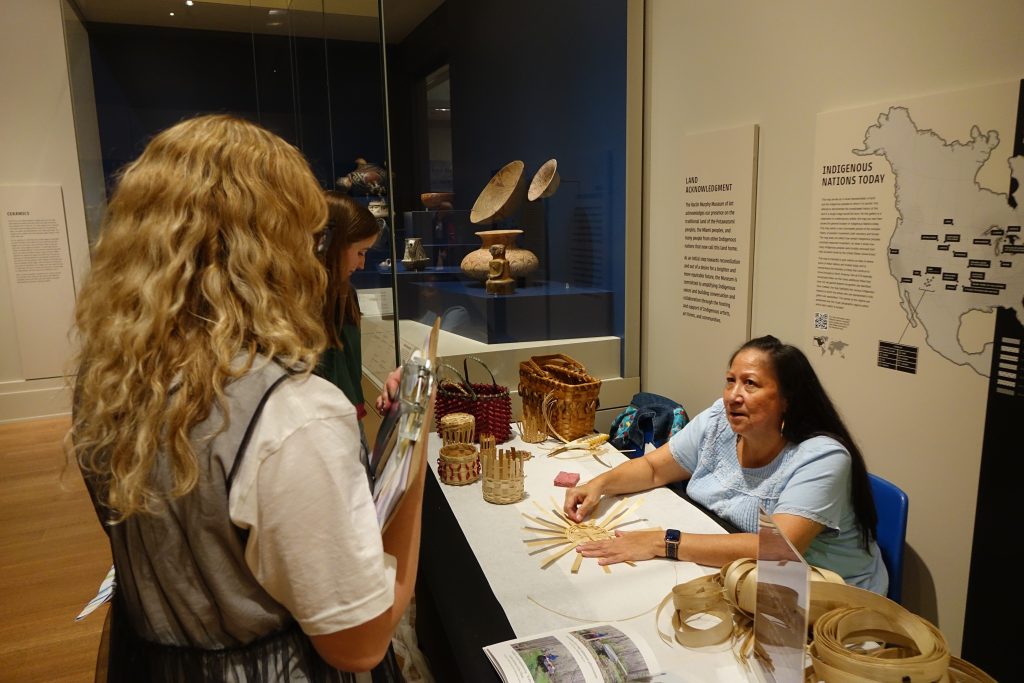
Christine Marie Rapp-Morseau, a member of the Pokagon Band of Potawatomi, explains basket weaving to onlookers. Rapp-Morseau has work on display in the Raclin Murphy Museum of Art.
“Most major museums have a significant portion of their collection – medieval, Renaissance, Baroque – that is religious,” Becherer said. “However, none of those objects were made for a museum. They were made for a chapel, they were made for somebody’s home and personal devotion, they were made for a basilica, so on and so forth. So as time has progressed, the original context, the original animated life of those objects, was taken away. And so one of the things that I in particular wanted to do was to help people understand that so much of what they’re seeing in the medieval galleries
or the Renaissance galleries was actually an object that had another life before it became part of the museum collection.”
According to Becherer, another of the intentions for the chapel was to showcase contemporary religious art. The chapel will be used for Mass and will be open for personal prayer.
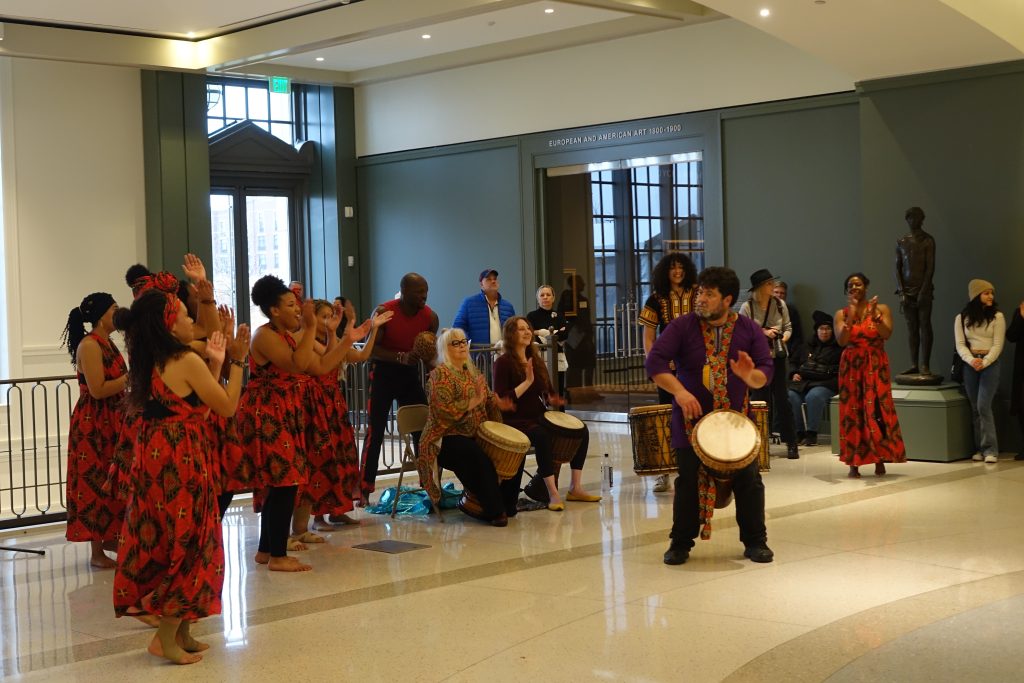
Dance and drumming group UZIMA! performs in the lobby of the Raclin Murphy Museum of Art while visitors look on from both levels. UZIMA! was one of many groups the University of Notre Dame brought in during the museum’s grand opening.
More broadly, on the Catholic identity of the university and how it fits with the museum, Becherer said: “The history of art and the history of the Catholic Church have been conjoined since they put fish and loaves and little sheep on the catacomb walls. So there’s a long history there. Not that this is a religious art museum. But it’s a religious collection in many parts … that basically has a responsibility to keep stories and narratives alive.”
Rebecca Walton, a local artist and teacher at Saint Thomas More Academy, visited the Raclin Murphy Museum of Art on opening night as well as later in the weekend. “The gallery spaces themselves have been beautifully laid out with attention to proportion and color, which showcase the collections wonderfully,” Walton said. “South Bend is certainly fortunate to have a place devoted to both the stewardship of art and the education of the community.”
Similarly, Becherer stressed the accessibility of the museum, both in its central location and free admission. While the museum is a central point for the University of Notre Dame and used by more than 40 of its academic departments every year, Becherer said it is intended to be a “bridge” between the university and the larger community.
“Anybody’s welcome here. Everybody’s welcome here,” Becherer said.
The best news. Delivered to your inbox.
Subscribe to our mailing list today.



